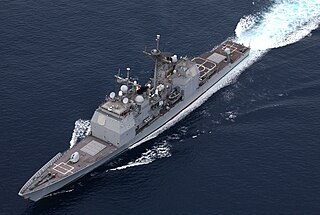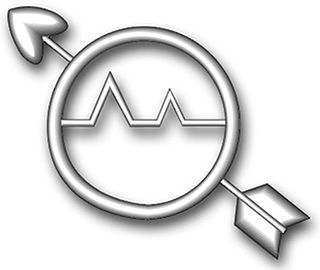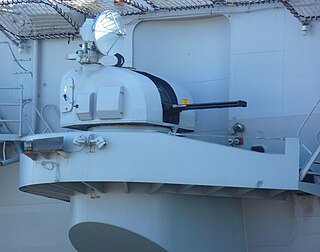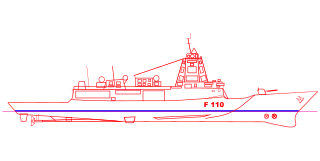
The Aegis Combat System is an American integrated naval weapons system developed by the Missile and Surface Radar Division of RCA, and now produced by Lockheed Martin. It uses powerful computer and radar technology to track and guide weapons to destroy enemy targets.

The Halifax-class frigate, also referred to as the City class, is a class of multi-role patrol frigates that have served the Royal Canadian Navy since 1992. The class is the outcome of the Canadian Patrol Frigate Project, which dates to the mid-1970s. HMCS Halifax was the first of an eventual twelve Canadian-designed and Canadian-built vessels which combine traditional anti-submarine capabilities with systems to deal with surface and air threats as well. All ships of the class are named after a major city in each province plus the cities of Ottawa and Montreal.

Will Chapel Rogers III, is a former officer in the United States Navy, most notable as the captain of USS Vincennes, a Ticonderoga-class Aegis cruiser. While under his command, the ship shot down Iran Air Flight 655 in the Persian Gulf, killing 290 civilians and creating an international incident.

The Zumwalt-class destroyer is a class of three United States Navy guided missile destroyers designed as multi-mission stealth ships with a focus on land attack. It is a multi-role class that was designed for secondary roles of surface warfare and anti-aircraft warfare and originally designed with a primary role of naval gunfire support. The class design emerged from the DD-21 "land attack destroyer" program as "DD(X)" and was intended to take the role of battleships in meeting a congressional mandate for naval fire support. The ship is designed around its two Advanced Gun Systems, their turrets and magazines, and unique Long Range Land Attack Projectile (LRLAP) ammunition. LRLAP procurement was cancelled, rendering the guns unusable, so the Navy re-purposed the ships for surface warfare.

The RIM-116 Rolling Airframe Missile (RAM) is a small, lightweight, infrared homing surface-to-air missile in use by the German, Japanese, Greek, Turkish, South Korean, Saudi Arabian, Egyptian, Mexican and U.S. Navies. It was intended originally and used primarily as a point-defense weapon against anti-ship cruise missiles. As its name indicates, RAM rolls as it flies. The missile must roll during flight because the RF tracking system uses a two-antenna interferometer that can measure phase interference of the electromagnetic wave in one plane only. The rolling interferometer permits the antennas to look at all planes of incoming energy. In addition, because the missile rolls, only one pair of steering canards is required. As of 2005, it is the only U.S. Navy missile to operate in this manner.

The Álvaro de Bazán class, also known as the F100 class, is a class of Aegis combat system-equipped air defence frigates in service with the Spanish Navy. The vessels were built by Spanish shipbuilder Navantia in Ferrol, with the lead ship of the class named for Admiral Álvaro de Bazán.

Naval Tactical Data System (NTDS) was a computerized information processing system developed by the United States Navy in the 1950s and first deployed in the early 1960s for use in combat ships. It took reports from multiple sensors on different ships and collated it to produce a single unified map of the battlespace. This information could then be relayed back to the ships and to the weapons operators.

The Hobart class is a ship class of three air warfare destroyers (AWDs) built for the Royal Australian Navy (RAN). Planning for ships to replace the Adelaide-class frigates and restore the capability last exhibited by the Perth-class destroyers began by 2000, initially under acquisition project SEA 1400, which was re-designated SEA 4000. Although the designation "Air Warfare Destroyer" is used to describe ships dedicated to the defence of a naval force from aircraft and missile attack, the planned Australian destroyers are expected to also operate in anti-surface, anti-submarine, and naval gunfire support roles.

A combat information center (CIC) or action information centre (AIC) is a room in a warship or AWACS aircraft that functions as a tactical center and provides processed information for command and control of the near battlespace or area of operations. Within other military commands, rooms serving similar functions are known as command centers.

DATAR, short for Digital Automated Tracking and Resolving, was a pioneering computerized battlefield information system. DATAR combined the data from all of the sensors in a naval task force into a single "overall view" that was then transmitted back to all of the ships and displayed on plan-position indicators similar to radar displays. Commanders could then see information from everywhere, not just their own ship's sensors.

The Sejong the Great-class destroyers, also known as KDX-III, are three guided missile destroyers of the Republic of Korea Navy (ROKN). The ROKN has deployed three ships with an option for three more which was taken up in December 2013.
Lockheed Martin Rotary and Mission Systems , formerly known as Mission Systems and Sensors and then Mission Systems & Training, is a Lockheed Martin business segment, headquartered in Washington, DC. Until October 2008 MST was headquartered in Moorestown Township, New Jersey, a suburb of Philadelphia; Moorestown remains the largest site in the business unit and is where many of the unit's top executives have their offices. As of 2013, MST is one of Lockheed Martin's five operating units; prior to that it was a part of the now-defunct Electronic Systems sector. MST was formerly known as Maritime Systems and Sensors (MS2) and prior to that NESS. Frank St. John is the current executive vice president of RMS.

The AN/SPS-49 is a United States Navy two-dimensional, long range air search radar built by Raytheon that can provide contact bearing and range. It is a primary air-search radar for numerous ships in the U.S. fleet and in Spain, Poland, Taiwan aboard Oliver Hazard Perry-class frigates, Canada on its Halifax-class frigate, New Zealand on its Anzac-class frigates and Australia on its Adelaide-class frigates and Anzac-class frigates. It formerly served in a complementary role aboard Aegis cruisers with the AN/SPY-1 but the systems are currently being removed during routine upgrade with no replacement.

Operations Specialist is a United States Navy and United States Coast Guard occupational rating. It is a sea duty-intensive rating in the Navy while most of Coast Guard OS's are at ashore Command Centers.

The Meroka CIWS is a Spanish Navy 12 barrelled 20 mm CIWS, using twelve Oerlikon 20 mm/120 guns mounted in 2 rows of 6 guns each. The system's primary purpose is defence against anti-ship missiles, and other precision guided weapons. However it can also be employed against aircraft, ships and other small craft, coastal targets, and floating mines. The weapon is mounted primarily on Spanish naval vessels, from frigate size upwards.
Geophysical MASINT is a branch of Measurement and Signature Intelligence (MASINT) that involves phenomena transmitted through the earth and manmade structures including emitted or reflected sounds, pressure waves, vibrations, and magnetic field or ionosphere disturbances.

The RIM-66 Standard MR (SM-1MR/SM-2MR) is a medium-range surface-to-air missile (SAM), with a secondary role as anti-ship missile, originally developed for the United States Navy (USN). A member of the Standard Missile family of weapons, the SM-1 was developed as a replacement for the RIM-2 Terrier and RIM-24 Tartar that were deployed in the 1950s on a variety of USN ships. The RIM-67 Standard (SM-1ER/SM-2ER) is an extended range version of this missile with a solid rocket booster stage.

The AN/SPY-1 is a United States Navy 3D radar system manufactured by Lockheed Martin. The array is a passive electronically scanned system and is a key component of the Aegis Combat System. The system is computer controlled, using four complementary antennas to provide 360 degree coverage. The system was first installed in 1973 on USS Norton Sound and entered active service in 1983 as the SPY-1A on USS Ticonderoga. The -1A was installed on ships up to CG-58, with the -1B upgrade first installed on USS Princeton in 1986. The upgraded -1B(V) was retrofitted to existing ships from CG-59 up to the last, USS Port Royal.
Cooperative Engagement Capability (CEC) is a sensor network with integrated fire control capability that is intended to significantly improve battle force air and missile defense capabilities by combining data from multiple battle force air search sensors on CEC-equipped units into a single, real-time, composite track picture. This will greatly enhance fleet air defense by making jamming more difficult and allocating defensive missiles on a battle group basis.

The F110 class also known as the Bonifaz class are a multi-purpose, anti-submarine class of Aegis combat system-fitted heavy frigates under development for the Spanish Navy. The project is being co-developed by the Spanish Ministry of Defence and the state owned company Navantia. The construction of the frigates is to begin by 2020 and are scheduled to be delivered between 2023 and 2027.















